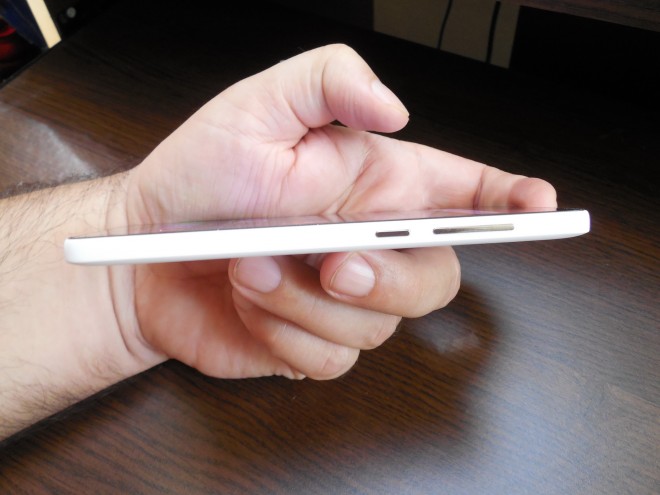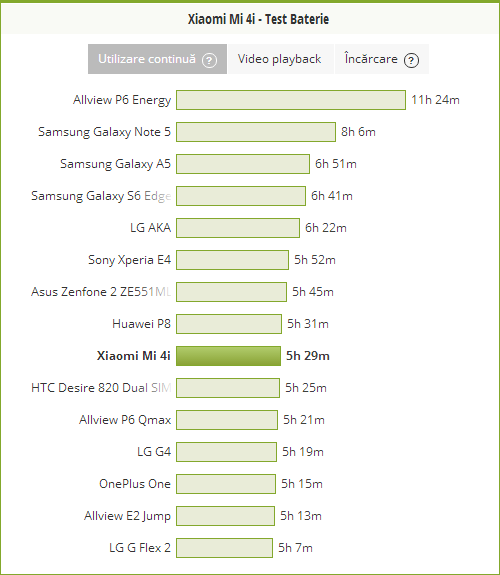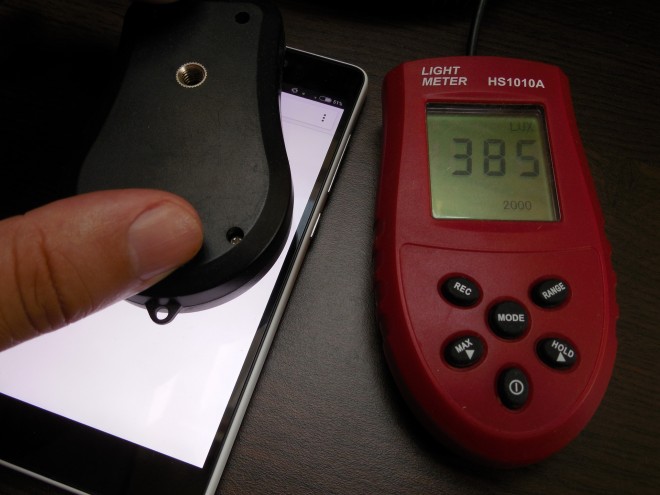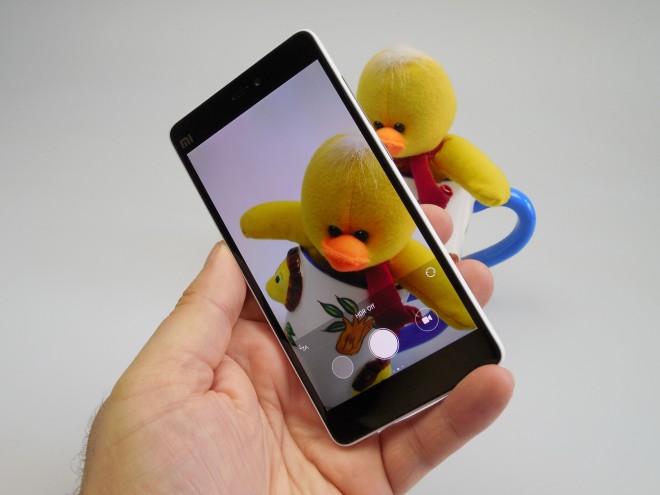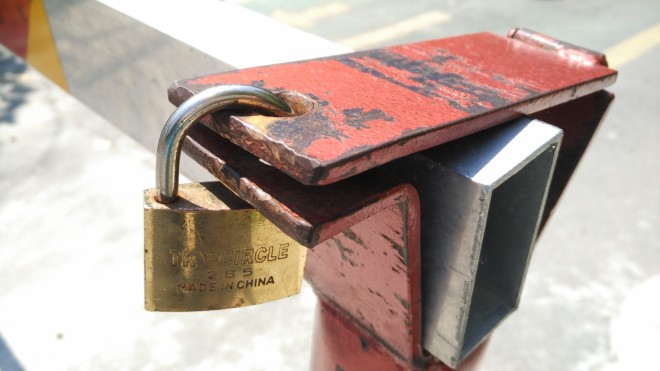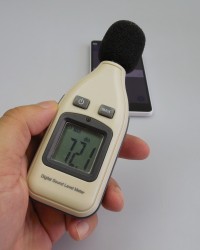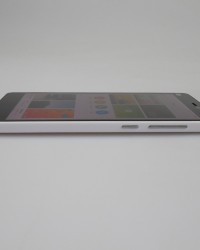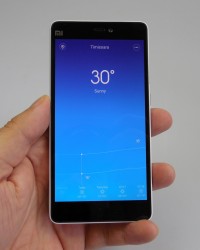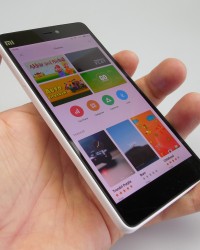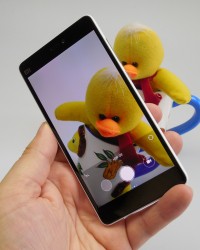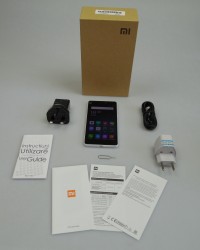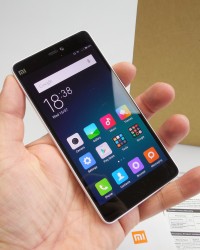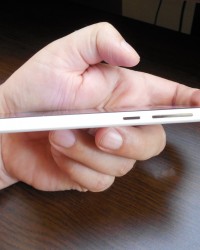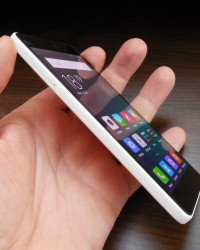Xiaomi Mi 4i is the very first Xiaomi phone we tested, a device that was launched in India in April and soon will get a version called the Mi 4c, with improved specs. The device is priced at $202 in India and on paper it should be able to fight the 2014 flagships. Let’s see if it does!
This one is a dual SIM handset with MIUI 6 on board and its design is reasonably slim at 7.8 mm in waistline. The handset weighs 130 grams and feels a bit like a first generation Lumia, design-wise. Xiaomi Mi 4i is a small and compact phone, with a soft touch back and a comfy case. It has reasonably thick bezels and also feels a bit like the iPhone 5c.
Its body has a solid build and it’s made of plastic at the back and sides. Xiaomi Mi 4i comes in gray, black, white, yellow, blue or pink and it’s slightly slippery. It’s pretty easy to use with a single hand and relies on a magnesium alloy structure inside. Upfront we find the earpiece, selfie camera, notification LED, sensors and capacitive buttons, while at the back there’s a special coating for fingerprint and grease resilience, then the main camera, dual LED flash and 114 speaker holes.
At the top there’s the audio jack, while at the bottom we find the microphone and microUSB port. The left side includes dual SIM slots of the micro SIM kind, that can be accessed using a special metal key. On the right side there are the stainless steel buttons (power and volume), that are comfy but flimsy and noisy. This is a light and comfortable to use handset, but also not a very original one design-wise.
The hardware includes a 5 inch Sharp made screen with JDI technology, Full HD resolution and an IPS LCD panel. The CPU inside the smartphone is an octa core Snapdragon 615, a 64 bit unit clocked at 1.7 GHz and we’re also getting an Adreno 405 GPU, 2 GB of LPDDR3 RAM, 16 or 32 GB of storage and no microSD. At the back we find a 13 megapixel shooter, while upfront there’s a 5 MP one.
On the connectivity side there’s 4G LTE, Bluetooth 4.1, dual band WiFi, WiFi Display, WiFi Direct, FM radio, GPS, Glonass and microUSB 2.0. Sensors include an electronic compass, gravity sensor, light sensor, gyroscope and proximity sensor. The battery of the Mi 4i is a 3120 mAh unit (Li-Po), that’s supposed to offer a Quick Charge feature, taking the battery up to 40% in 60 minutes, which to me doesn’t sound that impressive.
On paper the video playback is 11 hours and we also get 35 hours of talk time and 59 hours of music playback. In reality, our HD video playback test in a loop offered us 9 hours and 22 minutes, which is very good for a phone of this size. The test was taken with WiFi on and brightness at 50%. The 9 hours and 22 minutes are superior to the 9 hours of the Samsung Galaxy A5 or the 8 hours and 55 minutes of the LG G4.
HTC One M9 and its 6 hours and 9 minutes was also beaten. We did score below the Microsoft Lumia 640 XL LTE, but that’s a much bigger phone and it achieved 9 hours and 49 minutes. HTC One M9 also beat us, with 10 hours and 15 minutes. The PCMark battery test, that simulates continuous usage offered us 5 hours and 29 minutes of functioning on the Xiaomi Mi 4i, which is good.
We beat the HTC Desire 820 and its 5 hours and 25 minutes or the OnePlus One and its 5 hours and 15 minutes. However, Samsung Galaxy A5 scored higher, with 6 hours and 51 minutes, as did the LG AKA with 6 hours and 22 minutes. Charging takes 2 hours and 9 minutes, better than the HTC One M8’s 2 hours and 30 minutes, or the HTC One M9’s 2 hours and 20 minutes.
There are still performers out there, that need 1 hour and 55 minutes to charge, like the Samsung Galaxy S5, or the LG G Flex 2 and its 1 hour and 47 minutes. Overall the video playback time was very good and the battery is quite good. Settings for said battery include an estimation of its functioning time and various Battery Profiles. Those are Default (clear processes in the background when the device is locked), Marathon (disable data and WiFi) and Sleep (disable all network functions). Then there’s also a Custom option, letting you set the brightness, tweak the WiFi, GPS, Bluetooth, vibration and notifications as you please.
Battery Saver is another useful feature here, letting you switch to one of the profiles at a certain percentage. You can also schedule a profile switch, at a certain hour. The users can schedule power On/Off when needed. Then there’s an extra set of power options, like Performance or Balanced. They let you hide system animations among others. This impressive amount of battery functions is welcome, although a bit overkill.
Now let’s see what the acoustics are like. On the audio side I have to say there are no headphones bundled with the device and there’s quite a wide speaker at the back. Xiaomi offers Smart PA playback here, that amplifies sound. There’s also a small let’s say “stand” near the speaker, letting it be risen a bit on flat surfaces. The MIUI player is minimalistic and reminded me of iTunes a bit.
It can show offline and online songs and the actual listening experience involved a clear, crisp and not very loud sound. The bass was OK and there was some muffling. We used a decibelmeter to measure performance and came up disappointed. We achieved 72.1 dBA at the front and 77 dBA at the back. Most phones we test get past 80 dBA easily. Lesser performers like the Amazon Fire Phone achieved 75.7 dBA, or the Xperia E4 76.2 dBA and still they were better compared to our model, at least when the sound was measured at the front of the device.
Sound options include headphones EQ, assigning headphone remote control features and Mi Sound Enhance. You can also choose headphone type and overall we found the acoustics to be lacking. Too bad for the lack of a speaker EQ as well…
Now the display enters our crosshair! It’s a Sharp/JDI production, a 5 inch Full HD unit, with a NTSC color gamut of 95%, which is good considering the iPhone 6 has 72% color gamut. The pixel density is 441 ppi and the screen has full lamination and Corning Concore Glass protection. The very same panel offers 178 degree wide viewing angle and relies on IPS LCD technology.
The video player is the Gallery, but there’s also a Video app hidden within the experience. The viewing experience brought us very vivid, bright and crisp images, with wide viewing angles and options in the player include volume, brightness and aspect ratio, as well as audio enhance. The contrast was OK and blacks weren’t very deep. Sunlight behaviour didn’t exactly impress here.
Pixels are of the RGB Stripe kind and the luxmeter test showed us 385 LUX, which is good for a midranger and even beats some hotshots. For example we surpassed the HTC One M9 with the Xiaomi Mi 4i, seeing how the former only gets 362 LUX. Huawei P8 and its 346 LUX was also surpassed, as well as the Huawei Honor 6 and its 383 LUX. Still, we scored below the OnePlus One and its 404 LUX, the HTC Desire 820 and its 396 LUX and other models that pass 400 LUX (Wiko Rainbow with 424 LUX).
Overall, the screen remains pretty bright and it gets some extra options in the Settings area. You can tweak brightness, set the double tap to wake gesture, fiddle with the contrast (auto contrast, increase contrast) and colors (warm, standard or cool). Font settings and one hand usage are also here, with the latter simulating the use of a 3.5 inch or 4 inch screen.
We move on from the good screen to the camera, a 13 megapixel shooter with both Samsung and Sony technology. It has F/2.0 aperture, a 5 element lens and two tone flash. Upfront there’s a 5 megapixel camera, with 36 beauty profiles and F/1.8 aperture, as well as wide angle lens. The main camera doesn’t have a fast startup, it freezes often and lags, at least before the update we received on this device.
The UI is transparent and minimal and with a swipe up you will trigger the capture options, like Refocus (tap to refocus), HHT (Night image stabilization/long exposure), Timer, Beautify (4 levels) and Front Camera. Once this is triggered it will try and guess your age. Then there’s panorama and manual options: ISO up to 3200, exposure time (from 1/1000 seconds to 2 seconds), focus (100 levels), white balance (cloudy, daylight, incandescent).
Settings include location, sounds, grid, QR, time, watermark, frame (16:9 or 4:3), burst, focus, picture quality (high, standard or low), face detection, show age, volume button functionality, anti banding and auto exposure (frame average, center weighted, shot metering). Finally, you can set up contrast, saturation and sharpness and if you swipe down, you will find 11 filters.
On the right there’s HDR with options like Off, Live or Pro, plus Flash options (Off, Torch, Auto). Video has its own options: HDR, slow motion, time lapse and stabilization, resolution (Full HD or HD), image capture while filming, focus mode (tap or CAF), time lapse interval. The camera offers a reasonably fast focus, fast picture taking and the zoom goes to 6.1X tops and it’s not very fluid.
If you tap on the screen you will trigger an exposure slider, from plus 2.0 to minus 2.0. Now let’s get to the gallery, where we have quite a few shots taken on a sunny July day. The camera lagged a lot during the test, which may have been the fault of heat or the not yet updated software. We have a crisp closeup of a locket and good texture in that image, then we see some detailed tree leaves and good colors generally.
The shade is exaggerated a bit and we had a good HDR shot of a bridge. The landscape shot was dark and not very clear. Panorama was burnt and not clear, plus it had a small resolution compared to what we’re used to: 2912 x 400 pixels. Blues are good and HDR is once again reasonably good. Selfies are clear, clean and crisp, so that’s an aspect we liked. If you zoom into the shots we’ve taken with the main camera, you’ll see that that details are not very impressive.
Closeups of flowers look nice and wall texture is crisp. Exposure, white balance and focus are reasonably good and once again I felt that quite a few shots felt burnt. Magic Focus was also tested and if you keep the screen pressed, you can change focus easily. Overall, this camera is good for flower closeups and selfies, plus it stands out through vivid colors.
The lag and freeze was annoying, since it happened a few times. The camera felt a bit superior to the HTC Desire 820 shooter and it’s way, way below the Huawei Honor 6, 6 Plus, P8 and P8 Lite. As far as video capture goes, Xiaomi Mi 4i films in Full HD, in MP4 format, at 30 FPS and with 15 Mbps bitrate. The first video we took was dark, not crisp and shaky. The second one was shaky too and had poor exposure, but OK quality in closeups. The mic couldn’t stand the wind.
The slow mo clip was OK and then things got really bad, with glitchy vids and blurry clips feeling like 480p, since probably the 40+ degrees Celsius got to the device’s “brains”. The filming was a total letdown, below the HTC Desire 820 and some 8 megapixel and even some 5 MP cameras. Editing is done with the usual crop, filter and adjust options.
As far as the temperature is concerned, the handset suffers a bit here, reaching 46.4 degree Celsius after playing 15 minutes of Riptide GP2 and gets even hotter if the environment temperature is risen. What’s worse is that when the device overheats, it also lags and glitches. The web browser is not very fast and the keyboard is also a bit laggy, but OK spaced.
The phone calling experience involves crisp acoustics, loud volume and a clear sound, but the signal is rather mediocre. We also did a few benchmarks, comparing the Xiaomi Mi 4i with the HTC Desire 820 and Huawei P8 Lite. The battle is between two Snapdragon 615 models and a Kirin 620 one. All these 3 phones have 2 GB of RAM and 8 core chipsets. These are the results:
Xiaomi Mi 4i wins 4 out of the 11 tests in front of the HTC and 8 out of 11 in front of the Huawei P8 Lite. The smartphone is not hugely impressive, it’s laggy and overheats, but those problems became rarer after the two or 3 updates we had during the review. Riptide GP2 runs OK, but seems to have some lag in the sound area. As far as the OS and UI go, we’re dealing with Android Lollipop here, with MIUI 6 on top, actually MIUI 6.6.6, which is creepy.
There’s no app drawer, since all the apps are placed on the homescreen and there’s lag, as I mentioned already a few times. Animations are long, there are freezes and the multitasking happens with the aid of the leftmost capacitive button. Icons are a bit childish, with generic symbols and if you pinch the screen, you can move apps around. Widgets are generic and minimal and you can tweak wallpapers and effects.
The dropdown area is transparent, barebones and feels like Emotion UI from Huawei. Settings include Do Not Disturb, Privacy, Notification Light, button settings, Mi Account, Mi Cloud and an extra notification menu. Xiaomi Mi 4i has quite a bit of bloatware on board. It has customizable themes and the app list includes: Mi Account, Mail, Updater, Calculator, Compass, Scanner, Report Bug, Downloads, Maps, Calendar, Notes, Weather, Security, File Explorer, Facebook, WPS Office, Swiftkey, Fleksy, Mi Store and the Google suite.
MIUI is quite RAM hungry and now it’s time for the verdict.
These are the Pros:
affordable phone
light and comfy
good battery
bright screen
OK picture quality when it comes to closeups and colors
good selfies
And these are the Cons:
volume is very low
not impressive video capture
some burnt and blurry pictures
overheat
laggy
bloatware
MIUI 6 is a big resource eater and not a very good looker
Xiaomi Mi 4i gets an 8.5 out of 10 for design, an 8.9 for hardware and a 6.5 for OS and UI. The final grade is 7.96 out of 10 and thanks to the affordable price, the grade jumps to 8.2 out of 10. It’s a sad case of a good phone with good hardware, spoiled by the software experience. Also, the camera could be a bit better… but the battery and screen remain strong.




